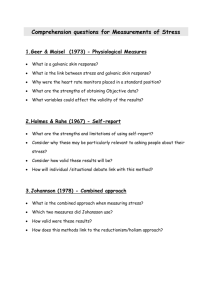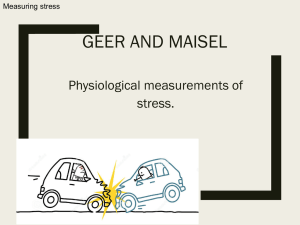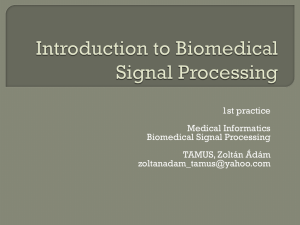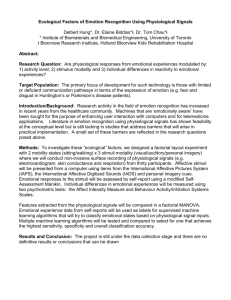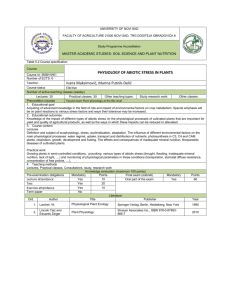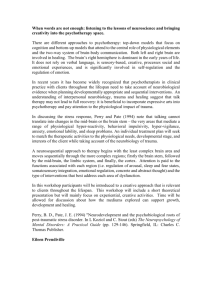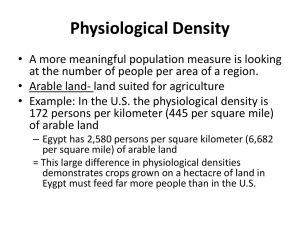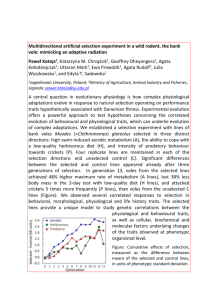1.Geer and Maisel (1972)-Physiological Measurements of Stress.
advertisement
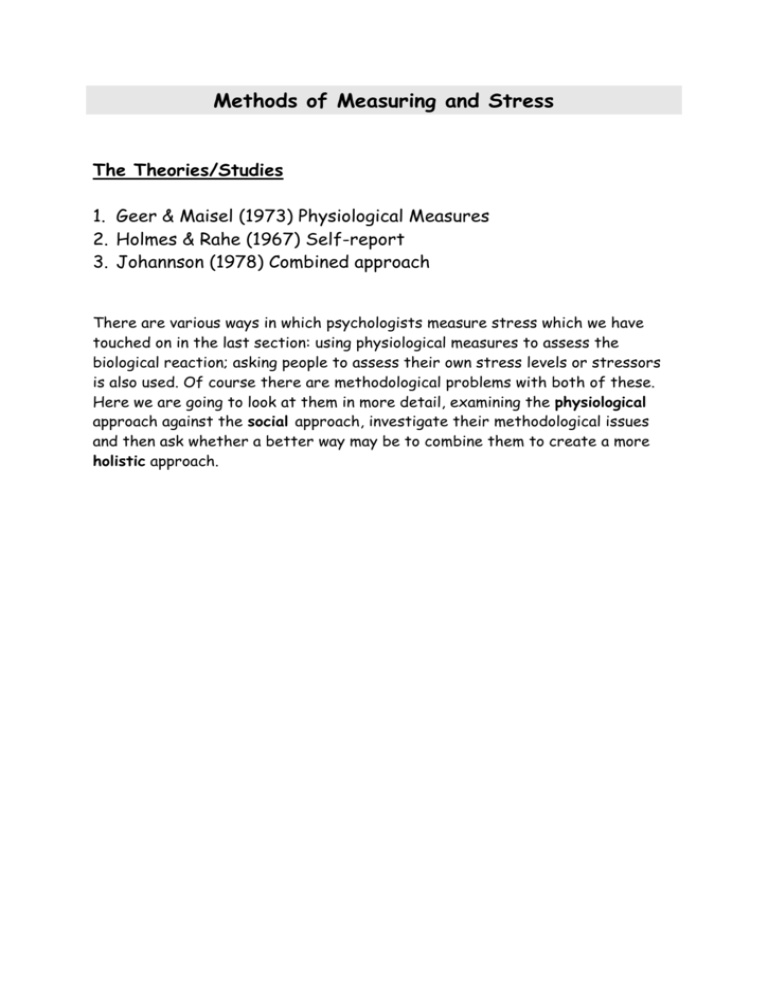
Methods of Measuring and Stress The Theories/Studies 1. Geer & Maisel (1973) Physiological Measures 2. Holmes & Rahe (1967) Self-report 3. Johannson (1978) Combined approach There are various ways in which psychologists measure stress which we have touched on in the last section: using physiological measures to assess the biological reaction; asking people to assess their own stress levels or stressors is also used. Of course there are methodological problems with both of these. Here we are going to look at them in more detail, examining the physiological approach against the social approach, investigate their methodological issues and then ask whether a better way may be to combine them to create a more holistic approach. 1.Geer and Maisel (1972)-Physiological Measurements of Stress. Background: Physiological measures of stress can overcome the subjectivity of the selfreport by relying on scientific measurements of hormones, chemicals, heart rate and blood pressure etc. the main problem with these is the validity. How can we be sure that we are truly measuring stress levels. Think about other factors which can cause physiological changes which can mimic stress reactions, caffine, recreational drugs or alcohol. Stress can be measured physiologically by any device that measures levels of arousal. Adrenaline causes increased blood pressure which can be measured. Goldstein (1992) found that paramedics had higher blood pressure during ambulance runs compared to at home. Galvanic Skin Response (GSR) measures the electrical resistance of the skin which is an indicator of the level of arousal in the nervous system. Good for labs but not normal life. Sample tests of Blood or Urine which can test the hormone level on the body secreted through these. Lundenberg (1976) commuters on train higher levels of hormone secreted on crowded short journey than long less crowded ride. Aim: To see if perceived control or actual control can reduce stress reactions to aversive stimuli (photos of crash victims). Approach: Physiological Type of Data: Quantitative Method: Laboratory experiment 60 psychology undergraduates from New York University. Independent design as participants were randomly assigned to one of three conditions. Details: Each participant was seated in a sound-shielded room and wired up to galvanic skin response (GSR) and heart-rate monitors. The machine was calibrated for 5 minutes while the participant relaxed and a baseline measurement was then taken. Instructions were read over an intercom. Each photo was preceded with a 10 second tone and then flashed up for 35 seconds (only the one group could terminate the photo and move on). The GSR was taken at the onset of the tone and during the second half of the tone and in response to the picture. Group 1: were given control over how long they looked at the images for. They could press a button to terminate the image and were told a tone would precede each new image. Group 2: Were warned the photos would be 60 seconds apart they would see the picture for 35 seconds and a 10 second warning tone would precede each photo. The group had no control but did know what was happening. Group 3: were told that from time to time they would see photos and hear tones but were not given timings or any control. • • • • A Beckman Model RB polygraph was used to collect psycho-physiological data. The data was converted from a voltmeter to a printout. Each recording was performed in a sound and electrically-shielded room to ensure no audio or visual input from the projector would interfere with the data collection. The heart monitors were attached in standard positions, and the GSR electrodes were placed between the palm and forearm of the participants’ non-preferred arm e.g. left arm for right-handed people. Results; The predictability group (Group 2) were most stressed by the tone as they knew what was coming, but did not have control over the photograph. The control group (Group 1) were less stressed by the photograph than the predictability group and no-control group (Groups 1 and 2) as they had control. Conclusions: Participants showed less GSR reaction, indicating less stress, when they had control over the length of time they could look at the disturbing photographs. It is likely that being able to terminate aversive stimuli reduces the stressful impact of those stimuli. 2. Holmes and Rahe (1967) Self–Report Measures: Life Events as Stressors. Background: Self-report methods include questionnaires, interviews and diary keeping. Holmes and Rahe used self-report measure with their Social Readjustment Rating Scale (SRRS). This looked at life events that have occurred in a person’s life and rates their importance. The readjustments need to cope with these life events causes stress, so the more life events you have to cope with the more stressed you are. Aim: Creating a method that estimates the extent to which life events are stressors Approach: Social Type of Data: Quantitative Method: In the correlation there was an independent design. A questionnaire designed to ascertain how much each life event was considered a stressor with 394 participants’ 179 males and 215 females, from a range of educational abilities, races and religions. Details: Holmes and Rahe examined the medical records of 5,000 patients (all American service men). From these, they put together a list of 43 life events which seemed to precede (come before) illness. 394 subjects (179 males and 215 females) from range of educational abilities and ethnic groups and religions took part. Each participant was asked to rate the series of 43 life events. Rating should be based on personal experience and perceptions of other people’s experience. The amount of readjustment and the time it would take people to readjust were to be considered They were told that ‘marriage’ had been given an arbitrary value of 50. The participants then had to give a number to each of the other life events, indicating how much readjustment they’d involve relative to marriage. Death of a spouse was judged (on average) to require twice as much readjustment as marriage. The resulting values became the weighting (numerical value) of each life event. The amount of life stress a person has experienced in a given period (e.g. 12 months) is measured by the total number of life change units (LCUs). These units are calculated by adding the mean values (in the right hand column of the table on the next page) associated with the events the person has experienced during that time. The ranks (left hand column) simply denote the order in which the life events appear in the SRRS. Most life events were judged to be less stressful than getting married. But 6, including death of a spouse, divorce and personal injury or illness were rated as more stressful. Holmes and Rahe found that people with high LCU scores for the preceding year were likely to experience some sort of physical illness the following year. For example, someone scoring over 300 LCU s had about an 80% chance of becoming ill. Results: Correlations between groups were tested and found to be high in all but one group. Males and females agreed. Participants of different ages, religions, educational level agreed. There was less correlation between white and black participants. Conclusions: The events chosen are mostly ordinary (although some are extraordinary. E.g. going to jail, but they do pertain to the western way of life). There is also some socially desirable events which reflect western values of materialism, success and conformism. The degree of similarity between groups is impressive and shows agreement in general at what constitutes a life event and how much they cause stress. Holmes and Rahe concluded that stress could be measured objectively as an LCU score. This, in turn, predicts the person’s chances of becoming ill (physically and / or mentally) following the period of stress. Stress and illness are not just correlated. Stress actually makes us ill. 3.Johansson et al.(1978) Combined Approach: Measurement of Stress Response. Background: The combined approach used both physiological and self-report can give us the objectivity of scientific measurements and rich qualitative data that helps understand behaviours such as stress. Aim: To measure the psychological and physiological stress response in two categories of employees. Approach: Physiological and Cognitive (psychological) Type of Data: Quantitative and Qualitative Method: A quasi-experiment where workers were defined as being at high risk (of stress) or in a control group. An independent design with participants (24) already working in one of the two categories, so no manipulation of the independent variable. The high-risk group (14 ) were classified as having jobs which were repetitive and constrained, little control of pace or work routine, more isolated and having more responsibility Details: Each participant was asked to give a daily urine sample when they arrived at work and at four other times during the day so that their adrenaline levels could be measured This is a physiological measure. Body temperature was also measured at the same time. These measures gave an indication of how alert the participants were These measures were combined with a self-report where each participant had to say how much caffeine and nicotine they had had since the last urine sample. They also had to rate a list of emotions and feelings such as sleepiness, wellbeing, calmness, irritation and efficiency. These were on a continuum from minimum to maximum and on a mm scale. The score was how many mm from the minimum base point they had marked themselves to be feeling. The baseline measurements were taken at the same time on a day when the workers were at home. This combined method of physiological measures and self-reports gave some good qualitative and quantitative data, which enabled Johansson et al. to compare the two groups, but have some understanding of the impact of higher stress levels on the participants Results; The high-risk group had adrenaline levels twice as high as their baseline and these continued to increase throughout the day. The control group had a peak level of 1 ½ times baseline level in the morning and this then declined during the rest of their shift. In the self-report, the high-risk group felt more rushed and irritated than the control group. They also rated their wellbeing lower than the control group. Conclusions: The repetitive, machine-paced work, which was demanding in attention to detail and was highly mechanised, contributed to the higher stress levels in the high-risk group. Activity Fill in the following table: Explanation Self-Report Physiological Combined Strengths Limitations Summary: Measurements of Stress As with measuring any behaviour, each method has its strengths and weaknesses, yet if psychology aspires to be accepted as a science we must acknowledge the objectivity of scientific methods. Just measuring chemicals or physiological responses will yield less information than the more qualitative data that self-report techniques can give us. Rich qualitative data can help us understand behaviours such as stress. Perhaps the combined approach is the most useful, though it may be most costly in terms of resources and time. Comprehension questions for Measurements of Stress 1.Geer & Maisel (1973) - Physiological Measures What is a galvanic skin response? What is the link between stress and galvanic skin response? Why were the heart rate monitors placed in a standard position? What are the strengths of obtaining Objective data? What variables could affect the validity of the results? 2.Holmes & Rahe (1967) - Self-report What are the strengths and limitations of using self-report? Consider why these may be particularly relevant to asking people about their stress? Consider how valid these results will be? How will individual /situational debate link with this method? 3.Johannson (1978) - Combined approach What is the combined approach when measuring stress? Which two measures did Johansson use? How valid were these results? How does this methods link to the reductionism/holism approach?
